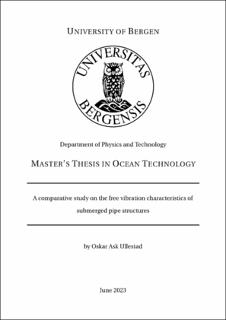| dc.description.abstract | This thesis investigates the free vibration characteristics of submerged pipe-like structures using multiple added mass approaches. Traditional methods rely on constant added mass factors, which may lack accuracy for complex structures, particularly those with bends and multi-plane topology. To address this, the coupled acoustic-structural approach (CASA) is employed to verify the natural frequencies of submerged structures. The simulated CASA results are compared with experimental data for verification. Four experiments involving different geometric objects are chosen—a straight pipe, cantilever plates, a stiffened cylindrical shell, and a disk. CASA accurately predicts the first three eigenvalues compared to experimental results. It successfully simulates bending, torsional, twisting, ovality, and stretching mode shapes, with less than ten per cent differences compared to experimental results. Furthermore, various added mass approaches are investigated and compared to the CASA results. These approaches include the lumped mass, increased density, nonstructural mass, and ABAQUS/Aqua. ABAQUS and MATLAB are utilized for eigenvalue and mode shape simulations. Shell, beam, and elbow elements are employed to model the structures in the added mass approaches, while solid elements are used in the CASA models. The investigation covers a straight pipe, two single-planar jumpers, and two multi-planar jumpers. The results indicate that adding mass to shell elements leads to inaccurate eigenvalue predictions compared to CASA. Torsional eigenvalues of the straight pipe and in-plane bending modes of single-planar jumpers cannot be correctly simulated using shell elements. However, shell elements perform well for lateral and out-of-plane bending modes. The results improve for multi-planar jumpers but still exhibit differences exceeding 16 per cent. On the other hand, adding mass with ABAQUS/Aqua to beam and elbow elements yields the most accurate results for single-planar jumpers, with differences compared to CASA below one per cent for all eigenfrequencies. For the straight pipe, it accurately predicts eigenfrequencies for both lateral bending and torsional modes. However, similar to shell elements, it encounters challenges in simulating multi-planar jumpers, accurately capturing eigenfrequencies for only one of the cases. Finally, a cost-effectiveness analysis is performed to assess the efficiency of different added mass approaches. Beam and elbow elements are thousands of times faster than CASA and several times faster than shell elements while demonstrating comparable memory usage. Additionally, the effects of added mass on bend ovalities are examined using CASA and the nonstructural mass approach. The eigenfrequencies exhibit slight increases due to thickness changes and significant decreases when the cross-section changes. | |
